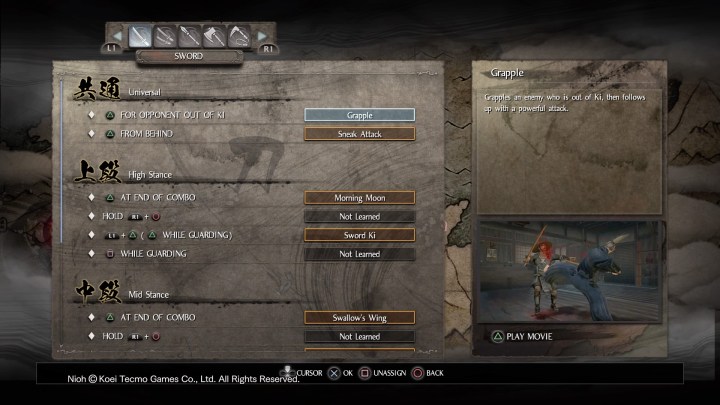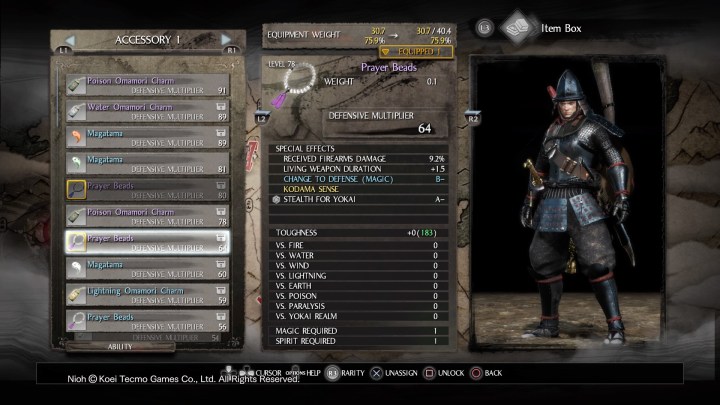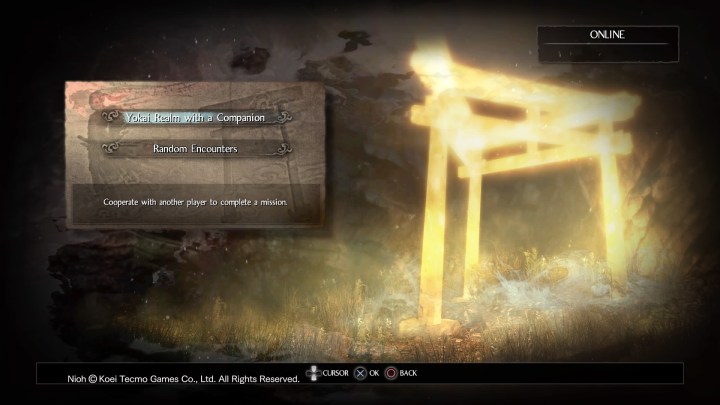Team Ninja’s Nioh was one of the coolest games to grace the last console generation. However, as a “Soulslike” title — aka, a challenging action-RPG with mechanics based on From Software’s Dark Souls series — it isn’t the easiest game to get into. But Nioh’s fast-paced combat, intricate levels, and story of a demon-infested Japan still make it worth the investment more than three years down the line. Even if you have the general concepts down, there are plenty of tricks that everyone, even experienced “Souls” players, should learn. After all, while it takes cues from games like Bloodborne and Dark Souls III, Nioh is its own game, with new systems to master.
So whether you’re a SoulsLike veteran or a quivering beginner, use these tips to get over Nioh’s steep learning curve and start your yokai-slaying career off right.
See more
Combat basics
If you’re new to this whole Soulslike genre, Nioh isn’t going to so much tell you how combat works as much as it will punish you until you learn to play by the rules. Don’t let that put you off, however, because once you learn how the game wants you to play, the combat can be some of the most satisfying you will experience.
Watch your Ki: Ki is your stamina, the green bar below your health. You use this to attack, dodge, block, and sprint, so you’ll need to manage it carefully. If you run it out completely, you’ll become exhausted and unable to move for a few moments. Don’t just spam your attacks or you’ll be left with no defensive options, and in a game where just a couple of hits means death, that makes all the difference. At the same time, enemies also have Ki that you can exploit by draining it with certain skills to leave them wide open to attack.
Learn to Ki Pulse: The Ki Pulse is your active reload equivalent if you’re familiar with that mechanic from Gears of War. If not, how it works is that after you perform an attack you can recover some of that Ki you spent right away by pressing the R1 button at the precise moment. You’ll see some light appear around your character that will flow into them. Time your press when the lights are as close as possible to recover the maximum amount of Ki and stay in the fight.
Change your stance: Every weapon you have can be wielded in three different stances: High, Middle, and Low. Each stance changes the moveset of the weapon, the speed, and the damage you will do. High stance is for slower, high-damaging strikes, Medium is a balance, and Low will allow you to perform a flurry of weaker attacks. Learn how each feels with the weapon you’re using, and change it up based on the situation you’re facing.
Change your gear: Nioh is, in addition to being a Soulslike, also somewhat of a Diablolike in how it handles loot. You’ll be swimming in armor, weapons, and accessories at the end of just a mission or two, so you should be constantly upgrading and swapping out your gear. I can get a little overwhelming, but you can just rely on the comparisons the game gives you to get a good idea of what is better until you settle into a style you like.
Important terms to learn
Nioh has so many features, items, options, and locations that it’s often difficult to even figure out what everything is for, especially when the game does a poor job explaining itself. Here are some of the important terms, in no particular order, you might be unclear on:
Amarita: Like Dark Souls’ “Souls,” you will earn this currency for defeating enemies, then use it to level up when you reach a shrine, the equivalent to Dark Souls’ bonfires. If you die, you drop the Amrita you’re carrying, and if you die again before you can return to the spot and retrieve it, that Amrita is lost forever.
Kodama blessing: The more tiny green Kodama spirits you find in each mission, the better the blessings you can receive. The healer blessing, which causes enemies to drop more elixirs, is generally the best.
Summoner’s candle: This item, which drops from some enemies, lets you reclaim your dropped Amrita without having to go pick it up and risking getting killed in the process and losing it.
Himorogi fragment/branches: You can use these items to quit a mission part way through. The fragment can be used at any time, but causes you to lose your accrued Amrita. The branches, while limited, let you keep it.
Hidden teahouse: This map location will be unlocked after a certain story mission. It lets you view online features like clan affiliation and trade Glory, a currency earned for using online features, for items and character skins.

Change guardian spirit: This lets you change your equipped spirit animal, which can alter your stats and your special “living weapon” attack.
Living weapon: When you’ve earned enough Amrita that the circular icon in the screen’s upper-left corner begins flashing, you can unsheathe a powerful living weapon. While the living weapon is active you don’t take damage, but getting hit speeds up the countdown to it disappearing. Killing enemies, on the other hand, gives you more time. Your equipped guardian spirit determines the weapon’s stats and element.
Make offering: This shrine page is the main way to get rid of unwanted weapons and armor, of which you’ll get plenty throughout the game. Lock the gear you want to keep with the square button, then select the rest with “triangle” or the right trigger and offer it all up for Amrita, elixirs, and other items.
Summon visitor: When you access a shrine within a mission, you can use “summon visitor” to invite other players into your game. If another player arrives, an item called an “ochoko cup” is used up; if you die or enter a boss fight before that happens, the cup is returned to you.

Training in the dojo: The dojo, which you can access from the starting point on the map, initially serves up training missions, but as you progress in the story additional missions unlocked there will grant you powerful skills if you complete them.
Blacksmith: The blacksmith isn’t just for forging weapons. She’ll buy your loot, sell you gear and ammo, and “soul match” your gear by fusing two items together for improved stats at a high price. She’ll also refashion gear to make it look like other gear, change your hair or beard once you unlock the ability to do so, and more. Talk to her using the triangle button for more options, and watch out for her grandpa, who you can rescue in a side mission to unlock even more options.
Torii gate: This is where you can go to be summoned into other players’ games or search for a player with whom to play specific missions.
Learn skills/skill customization: The “learn skills” menu is fairly straightforward. Each weapon type, along with ninja and magic skills, has its own skill page with nodes you can unlock for extra moves, equipment, and abilities. It’s worth it to read all the nodes for your weapon or skill category of choice. When you’ve unlocked multiple skills that use the same button combinations, you can change which skills are equipped for each weapon type in the skill customization tab.

Ready jutsu: This option in the shrine menu lets you choose which ninja and magic skills you have equipped. Your capacity in both categories is limited but can be increased by leveling certain stats or unlocking certain nodes in the respective skill trees. To use your readied jutsu, equip them to D-pad shortcuts from the equipment menu or by pressing “triangle” in the ready jutsu menu.
Titles: In the titles section of the touchpad menu, you can view your gameplay record, see accomplishments in the form of titles earned, and, most importantly, select minor stat buffs in the “prestige summary” menu. Be sure to check it every now and again.
Twilight mission: Twilight missions are harder versions of missions you’ve already cleared that give you better rewards.
Skills to unlock
It’s worth it to pore over the skill pages for your weapon type of choice, along with the ninja and magic skills, but some samurai just don’t have the time for that. Here are some skills we recommend you unlock ASAP, and some armor perks to watch out for.
Flux: The “Flux I” and “Flux II” nodes appear on all weapon skill trees. They both greatly increase your Ki (stamina) recovery when you change stances upon pulling off a ki pulse. If that doesn’t make sense to you now, don’t worry, it will soon, and it’s invaluable. Plus, investing in either flux skill on any tree unlocks it across all weapons.
Ki pulse/Living water: There are other universal perks, although, again, the way they’re organized is strange. On each skills page are three “ki pulse” nodes and three “living water” nodes, each with “heaven,” “man,” and “earth” variants. Interestingly, both sets of nodes upgrade your ki pulse: The “ki pulse” nodes increase your damage when you successfully trigger a ki pulse, and the “living water” nodes let you activate a ki pulse by dodging, so you don’t have to hit R1. Both are extremely useful.
Sloth talisman: Near the top of the Onmyo magic skill page, you’ll find the node “Talisman: Sloth.” Get as many of these as possible whenever you can, up to the max of six (you have to unlock the “Talisman: Lifeseal” node to reach it). The Sloth talisman slows enemies down considerably, making them much easier to fight, and they even work on bosses.
Blinding shell: Over on the ninja skill page, you can unlock blinding shells, which will render enemies unable to shoot or throw weapons at you.
Makibishi: The next node over from blinding shell is makibishi, which are spike traps you can throw on the ground behind you to slow down enemies chasing you.
Sneak attack: Further down on the ninja page is sneak attack, which will let you backstab unaware enemies for increased damage. It’s the only way to pull off a backstab in Nioh.
Increased ammo: Also on the ninja page are three nodes that will increase specific ammo types you can carry: “Quivermaker,” “shot pouch,” and “round carrier.” If you plan to use ranged weapons, these will be essential.

Kodama sensor: This last one is not an unlockable skill, but a perk you can find on equipment, especially accessories like prayer beads and charms. Kodama sensors cause Kodama spirits hidden in each level to appear on your radar, making it easier to find the invaluable little nymphs.
How to make progress
Getting through Nioh isn’t just about knocking out story missions one after another. Here are some things you should keep in mind as you play to help you prepare for what’s coming next.
Focus on one weapon type: When you’re starting out and skill points are more scarce, focus on one weapon type so you can unlock extra moves and get used to the controls. The sword is easy to master, although the Kusarigama — a sickle attached to a chain — has the coolest attacks.
Do side quests: Nioh is not the kind of game where you can skip the side quests and just blow through the story. Move too quickly, and you’ll find yourself increasingly underleveled and poorly equipped as you move forward. Skipping the optional missions means you’ll also miss out on story beats, new environments, valuable loot, and optional items like guardian spirits. Some of the side quests seem like an afterthought, but others feel just as important as the main story.
Redeem prestige points: In the “titles” section of the touchpad menu you can view your “prestige summary” and unlock incremental stat boosts. It’s worth checking out every few missions.
Clear out inventory: Try to clear out your inventory by offering unwanted items at a shrine every one or two missions. Keep anything that looks cool or is part of a set you might want, though.
Buy ammo from blacksmith: If you like to use ranged weapons to pick off foes before you close in, make sure to buy ammo at the blacksmith in between missions.

Do dojo missions: Throughout the story, you’ll unlock new missions at the dojo periodically. Do them to earn new skills.
Take your time: Seriously, don’t try to rush through Nioh. Take your time. Do some side quests, play co-op with friends or strangers, try out a Twilight mission. It’s a marathon, not a sprint.
Playing co-op
Nioh’s co-op works surprisingly well, especially given how troubled similar features in games like Dark Souls 3 and Bloodborne have been. It can be confusing if you want to do something specific, however, like play with friends. Here’s how it works.
Summon a stranger: To summon a stranger, select the “summon visitor” option at a shrine during a mission. You’ll have to give an ochoko cup as an offering, but you’ll get it back if no one joins you.
Summon a friend: Summoning a friend is like summoning a stranger but with one extra step. Head into the “online settings” section of the system menu, set a password, and make sure your friend sets the same password. Then select “summon visitor” as usual.

Help a stranger: At your initial location on the map, you will have to select the “Torii gate” site to signal to a stranger that you are available to help them. Click random encounters, and then you’ll have the option to enter a stranger’s game when they call for you.
Help a friend: You execute the same protocol for helping a friend as you would with helping a stranger with the addition of one more action. Enter a password in the “online settings” menu, go to random encounters, and turn the secret word on for your search.
Yokai realm with a companion: This is a fun option in the Torii game menu that allows you and another player to join a special mission. Not only can you choose how challenging you want the mission to be, but you also get several perks that come along with group play such as bringing each other back to life and using the same health bar.


